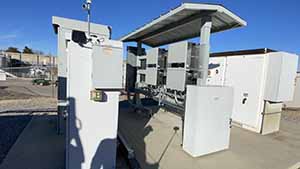

| Last updated: 11/3/2021 | |
|---|---|
Repowering a vintage utility-scale PV-system |
|
The system in question was built in 2008. It is rated at about 500 kW nominal. It has 2880 Conergy S175MU panels wired in strings of 12 feeding combiners, recombiners and two Xantrex GT250-480 negative ground inverters. One of the two inverters has failed. We need to find a solution to get the entire plant producing energy again. There are a lot of options, none of them perfect. See this page to learn about the tracking system. |
|
After we finished our research I wrote this paper that summarizes the issues and some conclusions we reached. |
|
| Below are considerations we explored in designing the upgrade. | |
OPTION |
DISCUSSION |
Repair existing inverters |
The only viable repair option is Schneider. Schneider offers a 2 or 3 year service contract. Schneider has not revealed the cost of this contract as of yet. They do require we purchase a spare parts kit at about $100k. There are other repair firms that claim to be able to repair these inverters but none responded to our request to schedule. |
Replace inverters |
The PV plant is built with components all limited to 600 VDC max. There are no inverters being built today on this scale that operate at less than 600 VDC input. They are all rated at 1,000 or 1,500 VDC. There are a few smaller 1000 volt rated inverters that might work with our lower voltage if we are willing to install a quantity of them. Some of these inverters can accept the combiner outputs as the inverter input, minimizing the rework. Some are designed to accept inputs from individual strings, not combiners, meaning the inverters would need to be installed at the arrays and the DC feeders re pulled as AC feeders. The PV wiring would not need to be redone in this scenario, saving a considerable amount of effort. |
Replace entire system. |
There are 2880 panels, 20 combiners, a lot of DC wiring and two large inverters, all limited to 600 VDC or lower operation. Replacing all of this equipment would be very expensive but would give the plant a new warranty. The other problem is what to do with the old panels if we remove them. We have not found any viable recycling program for these panels. |
Install optimizers |
Optimizers can kick the inverter input voltage up to a voltage greater than 600 VDC. The installation would require installing 2880 or 1440 optimizers and rewiring all of the PV arrays at some expense. It would also require upgrading the PV combiners, recombiners and all wiring to 1,000 volt rated equipment. Future upgrades might render this option obsolete prematurely. |
Install DC-DC converters |
DC-DC voltage upconverter could be installed at the arrays upstream or downstream of the combiners to increase the inverter input voltage to a value above 600 VDC. This has apparently been done by Solectria and Alencon Energy. Here is a link to a paper written on the subject. Future upgrades might render this option obsolete prematurely. |
Below are particulars of the existing system: |
|
|
Satellite view of site (click any thumbnail for full size view). The racking is a single-axis tracker. Here is a link to a description of the tracking. There are 10 long trackers of 42X4 and 10 short trackers of 30X4. |
There are 2880 of these panels. The long trackers have 14 strings of 12 and the short trackers have 10 strings of 12. Any retrofit would ideally match this pattern. |
|
Single Line Drawing |
Inverters behind recombiners |
|
Trackers |
Combiner |
|
Recombiner |
CONERGY PANEL SPECS |
Project Completion |
|
We chose Chint Power CPS60 inverters. They are designed for 1000 volt systems but the MPPT algorithm accepts voltage below 600 VDC. |
|
 New and old |
|
| Zip file for troubleshooting 3-4 | |
| CPS Sizing Tool | |